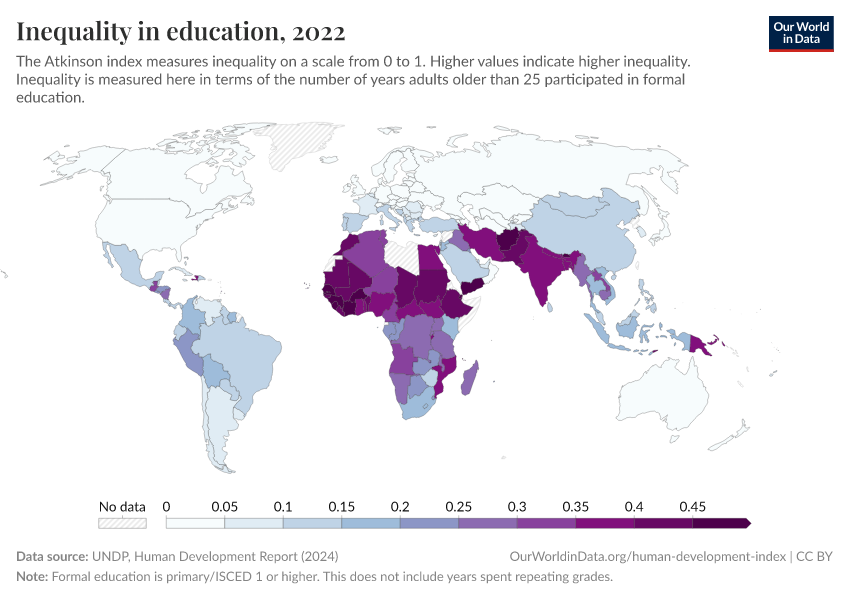Inequality in education

What you should know about this indicator
- Measures how unevenly educational attainment is distributed within a country. It is the Atkinson inequality measure (ε = 1) applied to years-of-schooling data.
- This version of the Atkinson index uses an inequality aversion parameter ε equal to 1. The parameter defines how sensitive the index is to changes in the lower end of the distribution. In this form, the inequality measure is A = 1 - g/μ, where g is the geometric mean and μ is the arithmetic mean of the distribution.
- Data are originally sourced from harmonised datasets, including CEDLAS and World Bank (2024), Eurostat's European Union Statistics on Income and Living Conditions (2024), ICF Macro Demographic and Health Surveys (various years), LIS (2024), United Nations Children's Fund Multiple Indicator Cluster Surveys (various years) and UNESCO Institute for Statistics (2024)
- This metric is used to estimate the Inequality-adjusted Human Development Index.
What you should know about this indicator
- Measures how unevenly educational attainment is distributed within a country. It is the Atkinson inequality measure (ε = 1) applied to years-of-schooling data.
- This version of the Atkinson index uses an inequality aversion parameter ε equal to 1. The parameter defines how sensitive the index is to changes in the lower end of the distribution. In this form, the inequality measure is A = 1 - g/μ, where g is the geometric mean and μ is the arithmetic mean of the distribution.
- Data are originally sourced from harmonised datasets, including CEDLAS and World Bank (2024), Eurostat's European Union Statistics on Income and Living Conditions (2024), ICF Macro Demographic and Health Surveys (various years), LIS (2024), United Nations Children's Fund Multiple Indicator Cluster Surveys (various years) and UNESCO Institute for Statistics (2024)
- This metric is used to estimate the Inequality-adjusted Human Development Index.
Sources and processing
This data is based on the following sources
How we process data at Our World in Data
All data and visualizations on Our World in Data rely on data sourced from one or several original data providers. Preparing this original data involves several processing steps. Depending on the data, this can include standardizing country names and world region definitions, converting units, calculating derived indicators such as per capita measures, as well as adding or adapting metadata such as the name or the description given to an indicator.
At the link below you can find a detailed description of the structure of our data pipeline, including links to all the code used to prepare data across Our World in Data.
Notes on our processing step for this indicator
We calculated averages over continents and income groups by taking the population-weighted average of the countries in each group. If less than 80% of countries in an area report data for a given year, we do not calculate the average for that area.
Reuse this work
- All data produced by third-party providers and made available by Our World in Data are subject to the license terms from the original providers. Our work would not be possible without the data providers we rely on, so we ask you to always cite them appropriately (see below). This is crucial to allow data providers to continue doing their work, enhancing, maintaining and updating valuable data.
- All data, visualizations, and code produced by Our World in Data are completely open access under the Creative Commons BY license. You have the permission to use, distribute, and reproduce these in any medium, provided the source and authors are credited.
Citations
How to cite this page
To cite this page overall, including any descriptions, FAQs or explanations of the data authored by Our World in Data, please use the following citation:
“Data Page: Inequality in education”, part of the following publication: Bastian Herre and Pablo Arriagada (2023) - “The Human Development Index and related indices: what they are and what we can learn from them”. Data adapted from UNDP, Human Development Report. Retrieved from https://archive.ourworldindata.org/20250909-093708/grapher/inequality-in-education.html [online resource] (archived on September 9, 2025).How to cite this data
In-line citationIf you have limited space (e.g. in data visualizations), you can use this abbreviated in-line citation:
UNDP, Human Development Report (2025) – with minor processing by Our World in DataFull citation
UNDP, Human Development Report (2025) – with minor processing by Our World in Data. “Inequality in education – UNDP” [dataset]. UNDP, Human Development Report, “Human Development Report” [original data]. Retrieved November 4, 2025 from https://archive.ourworldindata.org/20250909-093708/grapher/inequality-in-education.html (archived on September 9, 2025).